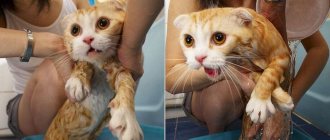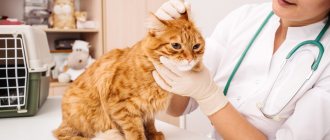Play aggression
A kitten or young cat can behave very rudely during play: scratching, biting, hunting for a person and attacking from an ambush.
Do not encourage your pet's aggressive behavior / bandofcats.com
The reason is that the animal simply does not know how to control itself. Cats typically learn to communicate when they grow up with their peers. This is how they learn that aggression can be met with a mirror response or the fun will end. But those kittens that were taken from their mother before the age of three months did not have time to acquire social skills. Therefore, they can play very harshly and simply do not understand that such behavior is unacceptable.
According to researchers of Common feline problem behaviors: Owner-directed aggression, the only pets that never go for walks and those whose owners prefer rather rough games can also show aggression. Such predatory habits are also typical for some breeds in general, for example, Bengal cats.
What to do about it
First, determine if there is a pattern when aggression occurs. For example, an animal hides under a bed when preparing to jump. To prevent an attack, distract your furry with a game or simply block access to ambush areas. An ordinary bell on the collar can tell you where the pet is.
Also try to switch your cat's attention to different toys. But do not expose your hands to scratching and biting: the animal may perceive this as a general game, which will provoke new aggression.
Don't punish your cat: sometimes this causes fear of people. If you see an animal showing play aggression, simply ignore it and walk away. This way the pet will understand that his actions do not lead to a common game.
Cat and man: friends or enemies?
If you think that by giving your pet a roof over his head and absolute security, you will relieve him of all worries, stress and fears, then you are making a mistake. In conditions of endless supplies of food, a “self-cleaning” tray and an owner who is friendly to the pet, the cat never stops fighting for survival.
It is difficult to give a definite answer to the question of what kind of relationship connects a cat and a person.
A common misconception is that the cat sees the owner as a patron or good friend. Depending on the circumstances, your pet may perceive you as a rival, a terrible pursuer, or even an enemy. In some cases, he may even claim to be a patron himself, bringing you dead mice and taking care of your diet.
Someone believes that for cats we are the same cats with whom we can compete, or we can make peace
It would be incorrect to deny the socialization of a cat that has lived side by side with humans for centuries. Of course, the pet gets used to its owner, whom it sees every day. Remembers those family members who treat him better and experiences positive feelings towards them in return. He recognizes strangers well and, as a rule, is in no hurry to make contact with them.
Cats never allow themselves to completely relax, even with an owner they know very well.
However, if you put aside the flair of sentimentality, you can easily discover that all the affection of felines for their owner sometimes quickly evaporates if there is a chance to escape. Not in all situations the pet takes advantage of this opportunity, but such escapes into the wild are by no means rare.
Affectionate now, cocky in a split second, cats are constant in their impermanence
At the same time, the Internet is full of videos in which an enthusiastic pet runs to greet its owner and throws itself on his neck with a purr. Isn't this proof of great love? Let's understand the contradictory cat behavior.
Aggression as a manifestation of fear
In certain situations, your pet feels cornered and defends itself if there is no way to escape. This often happens when a cat encounters an unfamiliar animal, person, or even noise. Although sometimes the owners can be frightening.
Another possible situation is events associated with less than pleasant experiences, such as a visit to the veterinarian.
During aggression, which is caused by fear, the cat tries to protect itself / webmd.com
This problem also occurs in animals that are not accustomed to people since childhood or are regularly subjected to physical punishment.
What to do about it
In such a situation, it is better to leave the pet alone for a while and give it the opportunity to come to its senses. It is important not to show fear. This behavior will only intensify if the cat realizes that you have retreated.
You should not reassure your pet; this may be perceived as encouragement. Lack of attention is the best way to deal with aggression caused by fear.
How to identify the cause of anger in a cat
Don't forget that a cat is not a dog, which is one hundred percent a pet. Cats still have wild instincts that tell them that anything can be dangerous, even humans. So, cats can show fear and begin to get angry in such situations:
- the child pulled the cat by the tail and the animal, in turn, begins to associate it with an object that can cause pain, and therefore shows unfriendliness towards it;
- a cat that is poorly adapted to the home will be afraid of everything around it, which, accordingly, will be expressed in manifestations of aggression.
To understand when to expect your cat to act aggressively, pay attention to body language . Some gestures directly indicate that your cat is about to attack either you or your children and relatives. Be especially careful when you see the following:
- the fur stood on end;
- pupils dilated;
- the cat is looking directly at you or a potential victim;
- or avoids eye contact;
- mustache pressed;
- the cat's ears are pressed to the head;
- the animal's posture is crooked;
- the cat growls, hisses, and begins to grin.
Every time your cat shows aggression, think about the reason for this behavior in the current situation. Perhaps he is frightened either by your actions, or by the presence of strangers in the house who seemed suspicious to him and the animal believes that they can harm him or you.
Interesting: How to stop a cat from marking its territory in an apartment
Aggression in response to affection
Some cats snap when they are petted or caressed or simply try to do so. Moreover, this happens both when trying to touch, and after some time.
A similar reaction is also sometimes observed during combing, nail trimming and other grooming procedures. There is no exact explanation for this behavior, but it is likely caused by overstimulation and an attempt by the pet to control the situation.
jacksongalaxy.com
According to research Potential risk factors associated with feline behavior problems, it is precisely such situations that account for approximately 40% of cases of aggressive manifestations towards people, higher rates only in gaming situations.
What to do about it
Try to be gentle when petting your pet or grooming its fur. When there is an outbreak of aggression, do not try to restrain and calm, do not punish for such behavior.
To prevent angry outbursts, give your cat treats after a short stroke. Over time, increase the contact time and don't forget about the goodies. But at the first signs of aggression, stop trying and do not touch the animal.
It is especially important to change this behavior if there are children in the family who often want to pet their pet and are not ready for negativity in response.
Treatment of aggression in cats
When raising the question of treating his pet, the owner usually finds himself captive to a very dangerous prejudice. In general terms, it sounds like this: it’s enough to take a prescription for some tranquilizer and give it to the cat so that it is calm and docile.
As practice shows, the real need for medications appears extremely rarely. At the same time, it is very easy to harm a cat’s nervous system with illiterate medicinal intervention. Since covering the range of medications that “calm” pets within the framework of this article is an impossible task, we will focus on alternative, easier treatment regimens.
Drug treatment is prescribed only in rare cases associated with pathologies of the nervous system
In their book on behavioral medicine for dogs and cats, Horwitz and Mills provide a list of methods that are not radical drug interventions, but have a positive effect on the pet. Let's stop at them.
Table 1. Methods for treating aggression in cats
| Therapy | Description | Peculiarities |
| Phytotherapy | It assumes a milder effect on the animal’s body compared to pharmaceutical drugs. When prescribing active ingredients, an assessment of the animal's character, environment and nutrition is taken into account. Many herbal medicines can be purchased without a prescription, but it is advisable to consult a veterinarian before purchasing. | Herbal remedies have their own effects. In particular, the exact dosage is important, since an excess of the substance can lead to intoxication. It is also necessary to take into account the compatibility of the essence with other drugs, if any are prescribed. |
| Aromatherapy | By influencing the animal's hypothalamus (the area of the brain responsible for the emotional state), certain aromas can change the cat's behavioral attitudes in a positive direction. Thanks to aromatherapy, your pet can relax and feel satisfied. The effect is unpredictable | Since animals are very sensitive to odors, a dominant odor risks temporarily disrupting their sense of smell. The cat may cease to adequately evaluate odors coming from the environment and emanating from other animals |
| Acupuncture (“skin needling”) | Acupuncture allows you to change your pet's hormonal status if it needs adjustment through the production of cerebrospinal fluid. Suitable for behavioral disorders and reduces signs of aggression | While working with manifestations, acupuncture does not address the root of the problem. At the moment, the effectiveness of acupuncture is in question, since the achieved results do not last long. While helping an animal get rid of attacks of aggression, acupuncture does not guarantee their absolute disappearance |
Redirected aggression
Occurs when the cat sees or feels the stimulus, but does not come into contact with it. For example, your pet observes a stray animal or a neighbor's pet through the window and even smells another animal. And if there is no opportunity to attack, aggression can be redirected to the person.
Sometimes cats redirect aggression towards people / petful.com
Sometimes the same behavior occurs due to loud noises and even the presence of strangers in the house.
What to do about it
The easiest option is to eliminate the irritant. For example, close the windows with curtains or isolate your pet from a neighbor. Various toys will also help distract the animal.
Manifestations of aggression
Let us dwell on the characteristic external manifestations of aggression, well known to all owners:
- Convulsive twitching of the tail, tapping it on the floor.
- Muscle twitching in the back area.
- Sudden change of posture, unnatural arching.
- Acoustic alerts - loud meowing, hissing.
- Increased avoidance of the stimulus.
- Unexpected scratching of the legs under the table;.
- A sharp jump from cover onto a person.
- Swinging front paws.
All these changes in the pet can be called signals that it gives to the owner before the attack. For what? To resolve the situation peacefully. If the owner is sensitive and listens to the pet’s “message,” the cat’s aggression will gradually fade away.
Giving advance warning of your displeasure is an essential cat trait.
It is important to remember that an attack of aggression never occurs suddenly, out of context (with rare exceptions). In order for the cat to take action, the owner must ignore a number of warnings. Sometimes it can be very difficult to understand what exactly the cat didn’t like. The following list of the most common “reasons for dissatisfaction” with your four-legged friend will help you understand the dilemma.
Aggression as a reaction to pain
This is how cats protect themselves from touching and other actions that can increase pain. For example, if you touch animals that have osteoarthritis or other conditions, they may hiss, scratch, and bite.
Try not to disturb animals during rehabilitation after injuries / bandofcats.com
Rarely, such manifestations of aggression can be observed even after complete recovery as a reaction to touching long-sore or injured areas.
What to do about it
Try to avoid touching that causes discomfort to the animal. Pet and comb your pet only when he is relaxed and not hissing or showing aggression.
Be sure to contact your veterinarian to relieve the pain.
Aggression caused by pain
Our pets cannot show where they are hurting, which sometimes makes it difficult to identify the real reasons for their behavior changes. Aggression associated with pain is easily confused with other types. It can be mistaken for an unreasonable “whim” or for overexcitation during affection.
Aggression in response to inflicted pain can manifest itself both when the tail is crushed by a careless owner, and when there are dangerous diseases of the pet’s internal organs, which are impossible to guess without the help of a specialist.
Frequent irritability in a cat may indicate health problems
By the way! Elderly cats should be handled especially carefully. In old age, they may develop arthritis, which causes pain if the pet is not handled carefully.
Painful aggression can also be combined with the above types. For example, while brushing or stroking a cat, you notice that it changes favor to anger whenever you touch a certain part of its body. If this behavior is repeated many times, then you need to pay attention to it. You can also read about the most common cat diseases on our portal. If a physical illness is suspected, it is advisable to have your pet checked by a veterinarian for possible minor injuries or illnesses.
Aggression after sterilization
Attacks of anger experienced by pets after sterilization are a special case of aggression caused by pain. Many owners mistakenly try to cheer up their pet with all sorts of games and treats, not realizing that after surgery, the best thing that can be done for the cat is to give it a rest.
Sterilization is difficult for a pet both physiologically and mentally.
There is no point in running for sedatives. As a rule, a change in a cat's mood is associated with poor health. Coming off of anesthesia, the first days with a slowly healing wound - these conditions can hardly be called easy. Therefore, if you want to help your pet with medications, then pay attention to painkillers.
The main task of the owner after sterilization of the pet is to provide him with rest and painkillers.
Important! Feeding your pet during the first 24 hours after sterilization is strongly discouraged. It is enough to give him water to avoid dehydration.
Special attention should be paid to the pet’s experience of anesthesia, which leaves an imprint on the pet’s mental state. Some cats may have poor tolerance to the gas used during surgery, which only complicates the situation.
What can the owner do?
Everything is the same as what is done to people who have undergone a complex operation. Give your pet peace and provide him with the necessary, but not intrusive, attention. Remember that anesthesia could affect the pet's coordination, and do not leave it alone for a long time - the cat may accidentally harm itself.
Territorial aggression
In this case, cats are aggressive towards other animals. Sometimes this even manifests itself towards old acquaintances whom the furries have already accepted but have not seen for some time. The cat attacks and even chases the stranger.
bandofcats.com
What to do about it
Accustom the animal to the neighborhood gradually. To start, leave your new or returning pet in a separate room with its own bed, litter box, and bowls. After a few days, place the aggressor in this room and let him be there alone for half an hour. Then swap the animals again. Repeat for several days in a row.
The next step is to put the pets in carriers and place them in different corners of the room. As an alternative, leashes with harnesses can be used if cats are accustomed to them. The main thing is that they can see and smell each other, but not be in physical contact. Give your pets treats at the same time so that positive emotions are associated with each other's company. If cats refuse to eat, increase the distance between them.
Repeat for several days in a row and gradually reduce the distance. When the aggression subsides, release the furries and offer them a treat. If anger appears again, start over.
This may take weeks or even months, depending on the characteristics of your pets.
If there is no progress for a long time, consult your veterinarian.
As studies have shown Common feline problem behaviors: Aggression in multi-cat households, there are key principles for the peaceful living of several cats in the same territory. First of all, the animals should not be crowded. They need enough space, as well as toys and even play complexes for active leisure. And if a tailed dog is brought into a house where there is already a pet, you need to gradually teach them to interact without aggression.
Aggression associated with gaming installation
Sometimes our pets begin to behave in the most bizarre way - they jump out of hiding and rush to the discouraged owner. After the prankster has been noticed, he hurries to disappear from sight again to repeat his triumphant attack.
Measuring strength during play is clearly not the prerogative of cats
In some cases, jumping out is accompanied by harmless scratching of the owner’s legs, which does not leave wounds. But sometimes such antics can leave behind bloody marks on the owner who remains perplexed. Some of the most harmless advances include the following:
- gentle biting of the owner’s legs or arms;
- fast running back and forth;
- light patting with a paw;
- attempts to jump to the owner's hands.
It would seem that the pet was not frightened, upset, or worried about anything. Didn't feel thirsty or hungry. On the contrary, stereotypical actions were more reminiscent of an abstract game of tag. But at a certain point they were complemented by excessive aggressiveness, which was not typical for the game.
Kitten games are not always as harmless as they seem at first glance
To understand this behavior, one should again turn to the pet’s possible problematic childhood, in which the basics of its mental constitution are laid. Many of us have witnessed the touching games of kittens, jumping on each other, biting their comrades by the tail, and so on.
From the outside, all these actions look harmless, but their instinctive background leaves no doubt - these are young hunters. In the strict sense of the word, the relationship between kittens cannot be called a game. It would be more accurate to call this the preparatory phase, during which the elements of predatory behavior are absorbed, which is normally realized as one grows older. At the right moment, the skills acquired during the “game” are redirected to mining.
There are both very playful pets that do not give the owner passage, as well as phlegmatic individuals
If something goes wrong and for some reason the kitten is separated from its mother and its brothers and sisters, it fails to establish the boundary between “play” and full-fledged predator behavior. Cats that gain independence too early literally “get stuck in childhood,” unable to correctly complete this stage.
Remember that proper setting of boundaries between you and your pet is the key to a good relationship
As a result, the owner gets what he gets - syncretic play behavior that conceals unrealized hunting attitudes. Since the pet does not feel the line between the first and second types of behavior, it can move from innocent flirtations and foolishness to quite serious combat manipulations without noticing. Hunting instincts will sooner or later make themselves felt at inopportune moments, unexpected for the cat himself, when he is “playing”.
Sometimes a cat, even with the best intentions, may not calculate his hunting prowess
Usually, behind all the advances there is one goal - to attract the attention of the owner. But since the cat cannot spend its energy resources as intended, their excess can be expressed in a lack of sense of proportion.
Video - British kitten games
What can the owner do?
Since the cat comes in peace by flirting with you, the best option would be to satisfy his need for play. For such cases, it is advisable to have several toys in the house that serve as mining simulators.
Don’t forget to pamper your pet with toys and your attention from time to time.
They should be easy and safe to chew, throw, scratch with claws. In a word, you need to try to create conditions as close as possible to the hunting conditions that your pet so lacks.
Important! Do not use your own hands or feet as bait during play if you do not want your pet to periodically have hunting sessions for parts of your body. The sooner the boundary between the cat and you is marked, the better it will be for your limbs.
Maternal aggression
Cats in late stages of pregnancy and nursing small kittens are often belligerent towards people, even people they know well. In such a situation, any attempt to approach may result in an attack.
Cats protect their kittens from any attacks / bandofcats.com
What to do about it
First of all, try to provide the cat family with a calm environment in a secluded place. Don’t bother them again and don’t let strangers get close to them. The situation will be resolved when the kittens mature and become more independent.
Helpful Tips and Warnings
Frequent aggression and anger in cats can be provoked by various reasons, which you cannot guess right away. Here are some tips and recommendations on this topic that may help you unravel the reason for your pet’s inappropriate behavior:
- sometimes aggression decreases after castration or sterilization of animals. If you do not plan to breed them in the future, think about it;
- if your cat reacts inappropriately to a neighbor’s cat or dog, agree with your neighbors so that their walk times do not coincide;
- anger and a feeling of fear overcome the cat when changing furniture, rearranging or moving;
- if you left and left the cat in the care of someone, then most likely its first reaction to your appearance will be aggression;
- Sometimes cats that are too well-fed show dissatisfaction because they cannot get rid of fleas. Everything can be resolved by visiting the veterinarian;
- To stop two cats in the house from quarreling, set up places for feeding them in different places in the room;
- Most cats are not enthusiastic about the need to go to the same litter box with another cat. They can be trained to go to the same litter tray, but it will be much easier to purchase one for each.
Interesting: Isn’t the friendship between a cat and a baby dangerous?
So, we understood one thing: you cannot respond to a cat’s aggression with aggression, everything needs to be resolved peacefully , let the animal understand that no one wants to offend him and everyone is welcome in this house. If he understands this, then he will forever change the attitude towards you and your guests who were afraid to come to you because of the evil cat.
No entries found.
Aggression towards other animals
Males, and sometimes cats, can be aggressive towards other males. This problem is especially relevant between the ages of two and four years.
Cat aggression is often caused by hormones / petside.com
What to do about it
A way out of this situation may be sterilization and temporary keeping of the aggressor separately from other pets, especially cats, for whom there is a struggle for the purpose of procreation. Afterwards, you should act in the same way as when suppressing territorial aggression.
How to calm a cat
calm a cat that is actively aggressive towards you in the following ways so that it does not cause you harm:
- put on protective clothing and take the animal in your arms, quickly wrap it in a blanket;
- Always have a water spray with you so that in case of aggressive behavior you can spray a little water in the direction of the animal. This way you will protect yourself from possible consequences;
- Do not tease or provoke the animal if you see impending aggression or after the first attack attempt.
Also, to curb the harsh behavior of the animal, the following actions should be taken:
- step away from the cat, you may need to leave the room for at least 10 minutes so that he “burns out”;
- if the cause of aggression is another cat or animal, then they should be isolated from each other for a while and introduced gradually;
- sit and do not look into the cat's eyes during the period of irritation, this will only increase its fear. You can lie down on the floor. This will make you seem shorter to the cat and it will calm her down;
- do not pay attention to the cat for a while so that he understands that you do not pose any threat to him;
- Make hiding places for your cat - sometimes staying in a safe shelter for a while helps calm the animal's negativity. If the cat is scared and has nowhere to run, the aggression will only intensify;
- approach the cat slowly and carefully, avoiding touching;
- or let him approach you himself so that the cat can be convinced that you are open to communication and do not want to hurt him. Let him sniff you, rub your head, so the animal will quickly understand that you are not as scary as he thinks;
- feed the cat or give it water;
- do not resort to punishment, otherwise attacks of aggression will be more frequent.
Interesting: How to stop a kitten or cat from shitting in the wrong place
What to do if your cat is acting aggressively
- Try to understand why your pet is acting hostile.
- Eliminate factors that cause aggression, including communication with other animals.
- Do not punish your pet - this may provoke new aggressive manifestations.
- Proceed gradually and patiently when introducing a new pet into a home with a cat.
- Try not to disturb tailed animals during and after illness, as well as nursing cats and kittens.
- Be careful when showing aggression; do not expose your cat’s hands or other parts of the body to avoid injury.
- Contact veterinary clinics for advice.
Aggression based on fear
Every owner who has once taken a cat to the veterinarian has encountered symptoms of this type of aggression. The pet spreads its paws, shows its fangs, and hisses. At any opportunity, he strives to slip out of the hands of a specialist and hide in a safe place. In the worst cases, it flies around the office, destroying everything in its path. In a state of passion, cats are capable of any miracles of acrobatics.
If a cat is scary in anger, then in panic he is three times more scary.
Similar behavioral attitudes can manifest themselves when meeting strangers, and when riding in a car or public transport. Aggression caused by a feeling of fear manifests itself in all cats, even the most sociable ones. But its severity and frequency of occurrence depend on the pet’s living conditions.
Prerequisites
The basis on which the feeling of fear will be based in the future is laid at an early age. It is believed that a kitten must necessarily spend the first months (preferably three months) next to its mother in order to satisfy its need for security.
If the cat did not receive enough maternal attention as a child, it will develop trust issues as an adult.
An early weaned kitten is more likely to have problems trusting anyone. This is especially true for kittens found on the street who have had to deal directly with fear, the threat of death and loneliness.
Cats walking on their own are unlikely to be tamed, maintaining their independence
Wild or stray cats who grew up without knowing human love are also at risk. Getting used to human hands happens to a kitten either in the first two months of life, or never happens. Of course, even adult cats gradually accept their permanent owners, but continue to treat them with great suspicion.
Reactive and preventive installations
If in domesticated cats aggression is more rational in nature (it is a response to an irritating stimulus), then in conditionally “wild” cats aggression becomes the basic mechanism of interaction. Every living creature is fraught with potential danger for them. To summarize, we can attribute manifestations of aggression to two fundamental behavioral attitudes:
- the reactive installation involves mobilizing the cat if necessary. Aggression is a response given to a cat's life-threatening stimulus;
- The preventive attitude determines the cat’s behavior as a whole. Aggression is a learned pattern of communication with the enemy, which everyone is, regardless of the actual degree of threat.
What can the owner do?
The best thing an owner can do in such emergency situations is not to do anything they would like to do. Namely, you should not immediately try to calm and reason with the animal, or pick it up. Fear is a strong affective state, so the best solution would be to allow the affect to take place and outlive itself.
The right decision when a cat is overcome by passion is to wait it out in conditions that are comfortable for the pet.
The more active your calming actions are, the more reasons the cat will have to suspect that you are the source of danger. Let the pet hide in any secluded place that he likes and wait out all the panic manifestations there.
During acute attacks of fear, you can help the animal by covering it with a box or wrapping it in a thick blanket to remove the irritant causing an acute reaction from sight. In a box or under a cloth, the cat will feel protected and will come to its senses faster, regaining strength after the adrenaline rush.
If possible, it is advised to avoid touching the cat at such moments - they will provoke an attack of aggression.
Important! All your actions aimed at calming the cat should be as smooth and careful as possible. Any sudden or awkward action can provoke a new aggressive outburst of the pet.
Painful aggression
Aggression is often caused by pain. During illness, an aggressive cat is hostile to any touch. The animal stops reacting adequately and may perceive any action as an attack.
Often capricious and aggressive cats become so because someone offended them . Just like people, cats can be vindictive. That is, if someone hurt a cat, then in return she will also try to hurt her.
Sometimes people can offend a cat and not notice it, but the animal remembers this and another time, seeing an irritated or angry person next to it, it attacks without warning. An aggressive pet is the first to fight so as not to get hurt.
Defensive aggression
If the cat is aggressive, then she must be left alone. Any attempts on the part of the owner who wished to calm his pet will be regarded by the cat as an encroachment on its safety. You can recognize a scared cat by the following signs :
- The animal huddles to the floor.
- The pupils are dilated.
- The pet hisses or growls.
- Ears flattened.
- An aggressive cat fearfully looks around and tries to find shelter.
In some cases, an aggressive cat may roll over on its back and fold its paws so that its position resembles a submissive pose. It is very important to recognize the animal’s condition so as not to get hurt or make the situation worse.
Rough cat play
If the only cat in the house is left alone for a long time, then due to its unspent energy, one can observe an excessively high playfulness of the animal. Attacks on owners during play indicate a lack of communication. The same problems arise from rough and improper games with a cat. They can also cause the cat to attack family members, encouraging it to behave aggressively.
As a distracting maneuver, inexperienced caregivers sometimes throw toys at the cat, which only encourages the animal to continue playing and increases its desire to attack its owner. In this case, you should persistently and consistently stop such cat games in every possible way.
Interspecies aggression
Anger caused by competition for territory, food or attention of the owner. In a group of animals (even if there are only 2 of them), there is always an “alpha” and her subordinates. Hierarchy is established through showdowns—hissing, displays of force, or even fights. However, from time to time a “subordinate” will claim the place of “alpha”. It happens that two pets live in perfect harmony, share a bowl, a bed and the affection of the owner, and suddenly, one cat shows aggression.
There are several reasons for anger:
- Hormonal surge.
- Competition for food or territory.
- Weakened "alpha" state.
You can't change nature and clashes will happen. Exit 2 - tolerate the pets' antics, risking their health, or sterilize the animals. After sterilization, one of the basic instincts in pets is dulled – sexual, which “removes” questions about defending territory or fighting for the hypothetical right to procreate.
What to do when stress is planned and inevitable
Before planned stress (moving, bringing a new pet into your home), you should start giving your pet sedatives prescribed by a veterinarian in advance. The effect of hormonal drugs, for example, is cumulative. It will not be possible to achieve the desired effect in two or three days.
If you have already had a sad experience of traveling with a pet (for example, the animal took a long time to come to its senses after a trip), then you should consult a veterinarian about the use of more potent drugs. You cannot give them to an animal yourself. The veterinarian will ask you what exactly the problem was and, based on this, will select the best option for the remedy.
Active aggression of cats
Aggression can also be more active or offensive in nature. In such cases, the cat initiates aggressive confrontations with another cat or person who is not a threat to it - these are attacks during play (often found in young cats). Aggression during play is also a source of so-called instrumental aggression, i.e. aggression as a means to achieve a goal.
Active aggression, unprovoked, and sometimes violent attacks seem to indicate a zero tolerance for the presence of another cat. This type of aggression is observed mainly when a cat attacks a new cat that has recently appeared in the house, or a cat that previously showed aggression, but lost its position due to certain reasons. The main function of aggression in such situations is to expel the object of aggression. Therefore, these forms of aggression are designated as territorial aggression.











